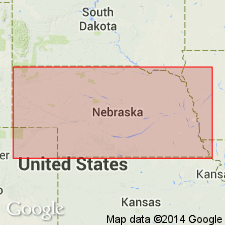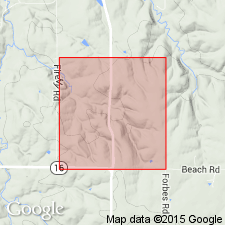
- Usage in publication:
-
- Havensville shale member
- Modifications:
-
- Original reference
- Dominant lithology:
-
- Shale
- AAPG geologic province:
-
- Nemaha anticline
Summary:
Pg. 32. Havensville shale. Middle member of Wreford limestone of Chase group. Is essentially an olive-colored argillaceous shale with fossiliferous transitional zones at top and bottom. Thickness 5 or 6 feet in southern Kansas; 15 or 16 feet southwest of Junction City and southeast of Randolph; and 18 feet or more at type locality in cuts on Highway 63 about 2 mi south of Havensville, Kansas. Overlies Fourmile limestone and underlies Schroyer limestone. [R.C. Moore (1936) replaced Fourmile limestone with Threemile limestone, but Nebraska Geol. Survey continues to use Fourmile limestone.] Age is Permian (Big Blue).
Source: US geologic names lexicon (USGS Bull. 896, p. 925); GNC KS-NE Permian Corr. Chart, Oct. 1936.

- Usage in publication:
-
- Havensville shale member*
- Modifications:
-
- Revised
- AAPG geologic province:
-
- Nemaha anticline
Summary:
Pg. 39-48. Havensville shale member of Wreford limestone of Chase group. Middle member of formation; overlies Threemile limestone member; underlies Schroyer limestone member. Condra and Upp (1931) state that thickness of Havensville at type locality is 18 to 19 feet, but 5 feet of shale and limestone at base is not definitely assigned to either the Threemile or the Havensville. These questioned beds are here included in Havensville. Also, at type locality, a limestone bed and overlying shale unit, both included as lower 3 feet of Schroyer limestone by Condra and Upp, are lithologically and paleontologically part of the Havensville. Thus, thickness of Havensville at type locality is 27 feet. Thickness varies from north to south across State; minimum thickness 1.5 feet in Chase County. Age is Early Permian (Wolfcamp).
Source: US geologic names lexicon (USGS Bull. 1200, p. 1704).
For more information, please contact Nancy Stamm, Geologic Names Committee Secretary.
Asterisk (*) indicates published by U.S. Geological Survey authors.
"No current usage" (†) implies that a name has been abandoned or has fallen into disuse. Former usage and, if known, replacement name given in parentheses ( ).
Slash (/) indicates name conflicts with nomenclatural guidelines (CSN, 1933; ACSN, 1961, 1970; NACSN, 1983, 2005, 2021). May be explained within brackets ([ ]).

